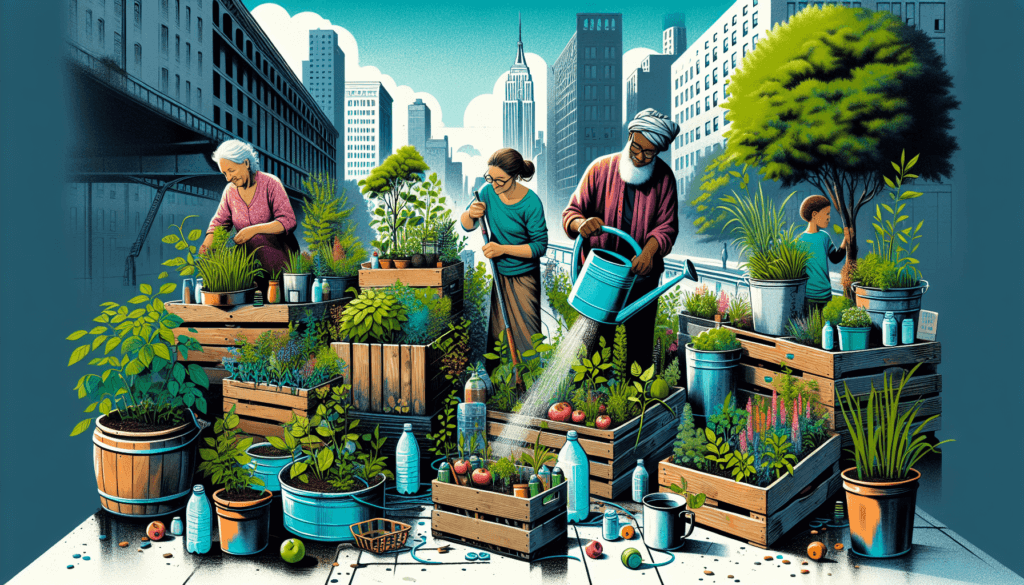Imagine transforming the dull and lifeless pavement of your neighborhood into a vibrant and thriving urban garden. With a few simple steps and minimal cost, you can bring a burst of nature to your city streets. In this article, you will discover the secrets to creating a low-cost urban garden on a pavement. From selecting the right plants to maximizing space, you will unlock the potential of even the smallest patch of concrete. Get ready to add a touch of green to your urban landscape and create a welcoming oasis for both people and pollinators alike.

Choosing the Right Location
Assess the Amount of Sunlight
When choosing a location for your urban garden, it is important to assess the amount of sunlight that the area receives. Most plants require at least six hours of direct sunlight each day to thrive. Take note of how the sunlight moves throughout the day and determine if your chosen spot will provide adequate sunlight for your plants. This will ensure that your plants receive the essential energy they need to grow and produce a bountiful yield.
Check for Access to Water
Water is a vital component for the success of any garden. Before setting up your urban garden, check for access to water in the vicinity. It can be challenging to constantly transport water to your plants if there is no water source nearby. Consider whether there are hoses or faucets available, or if you will need to rely on alternative methods such as rainwater harvesting. Access to water will make the watering process more convenient and efficient, giving your plants the hydration they need.
Consider the Foot Traffic
Another factor to keep in mind when choosing the right location for your urban garden is foot traffic. Avoid setting up your garden in an area with heavy foot traffic, as this can lead to damage to your plants. People walking by may accidentally step on or brush against your plants, causing them to become damaged or uprooted. Look for a spot that is situated away from busy pathways and consider placing a protective barrier around your garden to prevent any accidental or unwanted disturbances.
Preparing the Pavement
Clear the Area
Before you start setting up your urban garden on the pavement, it is essential to clear the area. Remove any debris, weeds, or unwanted plants that may be present. Clearing the area will create a clean and blank canvas for you to work with. It will also help prevent any competition for resources between your desired plants and existing vegetation.
Check for any Restrictions
Check for any restrictions or regulations that may be in place regarding the use of public space for gardening. Some cities may have rules or permits that need to be obtained before planting on pavements. It is important to be aware of these regulations to avoid any potential issues or fines. Contact your local authorities or gardening organizations to inquire about any necessary permissions for setting up an urban garden on a pavement.
Level the Ground
After clearing the area, it is important to level the ground before proceeding with your urban garden setup. Uneven pavement can lead to imbalances in water distribution and potentially cause damage to your plants. Use a level or a straight edge to ensure that the ground is even and flat. This will provide a stable foundation for your containers and promote proper drainage.

Selecting Suitable Plants
Research Suitable Plants for Urban Gardening
When selecting plants for your urban garden, it is important to research and choose varieties that are suitable for urban gardening. Some plants are more resilient to the challenges of growing in an urban environment, such as air pollution and limited space. Look for plants that have been specifically bred or recommended for urban gardening. These plants will be better equipped to thrive in the unique conditions of a pavement garden.
Choose Plants that Thrive in Containers
Since your urban garden will be located on a pavement, it is vital to choose plants that thrive in containers. Container gardening allows for more flexibility and mobility, making it an ideal choice for urban gardens. Look for plants that have compact root systems and do well in confined spaces. Herbs, salad greens, cherry tomatoes, and dwarf varieties of fruits and vegetables are excellent choices for container gardening in urban areas.
Consider the Size and Growth Habit of Plants
Consider the size and growth habit of the plants you choose for your urban garden. Since space may be limited on a pavement, it is important to select plants that won’t overwhelm the area. Look for plants that have a compact growth habit or can be easily trained or pruned to maintain a desirable size. This will ensure that your urban garden remains visually appealing and does not obstruct walkways or other public spaces.
Container Selection
Recycle and Repurpose Containers
When selecting containers for your urban garden, consider recycling or repurposing materials instead of purchasing new ones. Look for containers such as old buckets, barrels, or even discarded furniture that can be transformed into unique and functional planters. Not only will this reduce your costs, but it will also contribute to sustainable gardening practices by giving new life to discarded items.
Consider Drainage and Water Retention
Proper drainage is crucial for the health and success of your plants. Ensure that the containers you choose have sufficient drainage holes to prevent waterlogged roots. Additionally, consider containers that have good water retention capabilities. This will help to keep your plants hydrated and minimize the frequency of watering, especially in hot and dry urban environments.
Choose Lightweight and Portable Containers
Since your garden will be located on pavement, it is important to choose lightweight and portable containers. Lightweight containers will be easier to move, especially if you need to rearrange your garden or protect your plants from extreme weather conditions. Look for containers made of materials such as plastic, fabric, or lightweight metals. These materials will be durable, weather-resistant, and easy to handle.

Soil and Fertilizer
Test the Soil Quality
Before planting in your containers, it is recommended to test the soil quality. This will provide valuable information about the pH level, nutrient content, and organic matter present in the soil. Testing the soil will help you determine if any amendments or adjustments are necessary to create an optimal growing environment for your plants. Soil testing kits can be purchased at gardening stores or you can consult with local gardening experts or extension services for professional testing.
Amend the Soil with Organic Matter
To improve the soil quality in your containers, it is beneficial to amend it with organic matter. Organic matter, such as compost or well-rotted manure, will enrich the soil, improve its structure, and enhance its water-holding capacity. Mix in the organic matter thoroughly with the existing soil to ensure a well-balanced and fertile growing medium for your plants.
Use Slow-Release or Organic Fertilizers
Fertilizers provide essential nutrients to your plants and promote healthy growth. When choosing fertilizers for your urban garden, opt for slow-release or organic options. Slow-release fertilizers gradually release nutrients over time, reducing the risk of overfeeding your plants. Organic fertilizers, made from natural sources, are environmentally friendly and beneficial for the overall soil health. They help improve soil structure and provide essential micronutrients for your plants.
Planting and Maintenance
Start Seeds Indoors or Buy Seedlings
To get a head start on your urban garden, consider starting seeds indoors or purchasing seedlings from nurseries or garden centers. Starting seeds indoors allows you to control the growing conditions and ensure higher germination rates. It also gives you a wider selection of plant varieties to choose from. If you prefer the convenience of ready-to-plant options, buying seedlings is a great alternative. Simply transplant them into your containers and continue their care in your urban garden.
Plant and Space Plants Correctly
When planting in containers, it is important to follow proper spacing guidelines to ensure adequate airflow and prevent overcrowding. Refer to the specific plant’s requirements for spacing and depth to ensure optimal growth and development. Plant your seeds or seedlings at the appropriate depth and give each plant enough space to spread its roots and foliage without overcrowding neighboring plants. This will promote healthy growth and prevent competition for resources.
Water and Maintain Consistently
Consistent watering and maintenance are key to the success of your urban garden. Check your containers regularly and water the plants as needed, keeping in mind their specific water requirements. Be mindful of watering during hot and dry periods, as containers may dry out faster than plants in the ground. Additionally, regularly inspect your plants for any signs of pests, diseases, or nutrient deficiencies. Promptly address any issues to ensure the continued health and vitality of your urban garden.

Dealing with Pests and Diseases
Practice Integrated Pest Management
A proactive approach to pest control is essential in urban gardening. Integrated Pest Management (IPM) focuses on using a combination of prevention, monitoring, and intervention methods to manage pests effectively. Implement practices such as crop rotation, companion planting, and mulching to deter pests naturally. Regularly inspect your plants for signs of pests, and if necessary, use organic pest control methods such as neem oil, insecticidal soaps, or natural predators to keep pest populations in check.
Use Natural Pest Repellents
Another approach to dealing with pests in your urban garden is to utilize natural pest repellents. Many plants, herbs, and essential oils have natural repellent properties that can deter common garden pests. Consider planting companion plants such as marigolds, mint, or basil, which naturally repel pests with their strong fragrance. You can also make homemade pest repellents using ingredients like garlic, chili peppers, or vinegar. These natural options are safe for both your plants and the environment.
Identify and Treat Plant Diseases
Plant diseases can quickly spread and cause devastation in your urban garden. Regularly inspect your plants for any signs of diseases, such as wilting, discoloration, or unusual growth. If you notice any symptoms, identify the specific disease and take appropriate measures to treat and control it. Methods like removing infected plant parts, applying organic fungicides, or adjusting cultural practices can help mitigate the spread of plant diseases and ensure the overall health of your urban garden.
Vertical Gardening Ideas
Utilize Vertical Space with Trellises and Pergolas
One creative way to maximize space in your urban garden is to utilize vertical gardening techniques. Install trellises or pergolas in your containers to provide support for climbing plants. Vines such as beans, peas, cucumbers, or even flowering plants like morning glories or sweet peas can flourish in vertical spaces. This not only adds height and visual interest to your garden but also frees up valuable ground space for other plantings.
Plant Vines and Climbers
Vines and climbers are excellent choices for vertical gardening in urban areas. Opt for varieties that have a vining or climbing habit, which will naturally grow upward when provided with support. Consider plants like ivy, jasmine, passionflower, or grapes. Planting these vigorous climbers will not only add beauty and greenery to your urban garden but also provide additional shade and privacy to your space.
Hang Baskets and Pots
Another way to incorporate vertical gardening is to hang baskets and pots from structures or walls in your urban garden. Hanging baskets are ideal for cascading or trailing plants like petunias, lobelia, or trailing herbs. You can also hang pots from walls or railings, allowing you to grow a variety of herbs, flowers, or small vegetables vertically. This technique maximizes your growing space while creating a visually stunning display.

Watering and Irrigation Techniques
Install Drip Irrigation Systems
Efficient watering is crucial in an urban garden, where water resources may be limited. Consider installing drip irrigation systems to provide a consistent and targeted water supply to your plants. Drip irrigation systems deliver water directly to the plant’s base, minimizing water loss through evaporation or runoff. This method helps conserve water and ensures that your plants receive an adequate and consistent water supply, even during hot and dry periods.
Use Self-Watering Containers
Self-watering containers are an excellent option for urban gardens, especially for those with busy schedules or limited access to water. These containers have a built-in water reservoir that slowly releases moisture to the plant’s roots as needed. Self-watering containers can help maintain consistent soil moisture levels, reduce the frequency of watering, and prevent over or underwatering. They are particularly useful during the summer months when plants may require more water.
Mulch to Retain Moisture
To further conserve water in your urban garden, consider applying a layer of mulch to the soil surface. Mulch acts as a protective barrier, reducing moisture evaporation and suppressing weed growth. Organic materials such as straw, wood chips, or shredded leaves make excellent mulches. Apply a layer of mulch around the base of your plants, being careful not to cover the plant stems. This will help retain moisture in the soil, reduce the need for frequent watering, and promote a healthy growing environment.
Harvesting and Enjoying the Yield
Harvest Vegetables and Herbs at the Right Time
The joy of urban gardening comes when you get to harvest and enjoy the fruits of your labor. Harvest your vegetables and herbs at the right time to ensure the best flavor and quality. Each plant has specific harvesting guidelines, so it is important to familiarize yourself with the recommended harvest times for your chosen varieties. Harvesting at the peak of ripeness will provide you with the most flavorful and nutritious produce from your urban garden.
Preserve and Store Excess Produce
Sometimes, your urban garden may yield more produce than you can consume immediately. In such cases, it is important to have a plan for preserving and storing your excess produce. Consider methods such as canning, freezing, or drying to extend the shelf life of your fruits, vegetables, and herbs. This will allow you to enjoy the flavors and benefits of your homegrown produce throughout the year, even when the gardening season is over.
Create Recipes with Your Homegrown Ingredients
One of the most rewarding aspects of having an urban garden is the opportunity to create delicious recipes using your homegrown ingredients. Let your creativity shine in the kitchen by incorporating your freshest produce into your favorite dishes. From salads and stir-fries to homemade sauces and herbal teas, the possibilities are endless. Experiment with different flavors, textures, and combinations to savor the unique taste of your urban garden’s bounty. Share your culinary creations with family and friends, spreading the joy of homegrown goodness.

